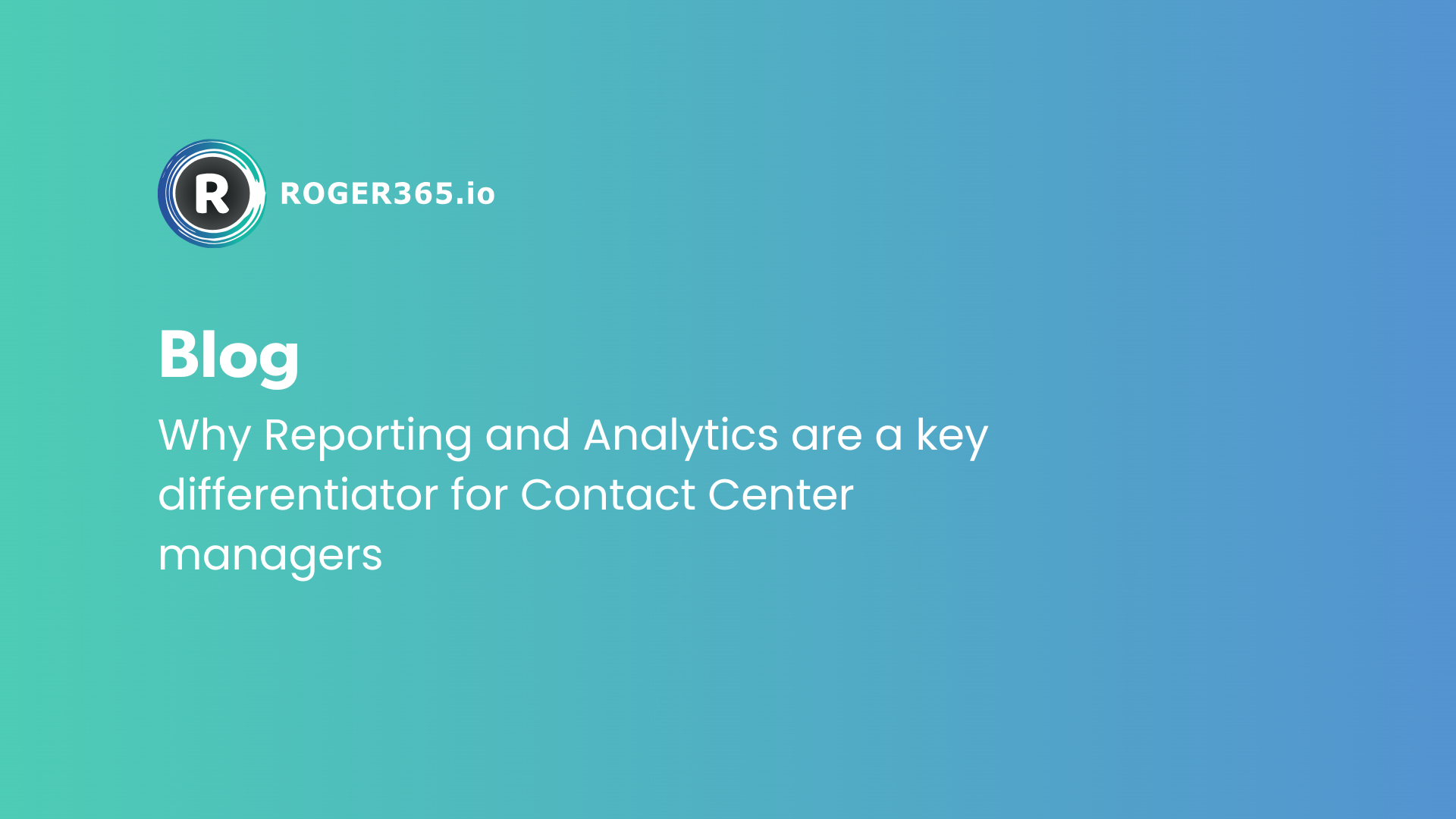Why Reporting and Analytics are a key differentiator for Contact Center managers
When used alongside real-time dashboards, reporting and analytics tools are the key to navigating your path to optimum contact center productivity.
In theory, these can be highly valuable to contact center managers. Yet, too often, the insights these deliver are too crude or basic to understand the details of what’s going on.
Intelligent decision-making can only happen when reporting is highly granular, covers all channels, and gives clear indicators for improvement.
In this blog, we’re going to see how ROGER365.io’s advanced Reporting and Analytics empowers you to make transformative changes to contact center operations.
As you’ll see, this can provide deeper insights that tell you much more about your performance across different domains.
And, by customizing the reporting and looking into the details it exposes, you can take decisive steps that improve efficiency, employee retention, and customer satisfaction.
Why is basic reporting no longer enough?
In our omnichannel era, customers may reach out via WhatsApp, webchats, voice calls, and many other channels.
This makes it much harder to unpick the customer experience, as calls may be routed through multiple overflow queues, a variety of channels, and different teams.
Standard metrics often fail to account for this, leaving you in the dark about how to improve things.
Contact center reporting should help answer questions like:
- Which agents are outperforming, and which need extra help?
- How well are social channels being handled?
- Which queues are busiest, when, and why?
- Which customers are calling the most?
- What are the most common queries?
To give contact center managers the data they need, ROGER365.io has built a powerful Reporting and Analytics module that gathers performance data from multiple perspectives, across all voice and social interactions.
Gaining a deeper understanding of performance with multiple perspectives
The Reporting and Analytics module gives you insights over 3 key perspectives:
- Caller perspective
- Queue perspective
- Agent perspective
By looking at each perspective individually and in combination, you can gain a better understanding of call handling efficiency and agent productivity.
At a glance, you can view important metrics such as total calls/social interactions, answer rates, average interaction time, and average ring time.
And, by diving into the details for each perspective, you can determine specific factors that affect your contact center performance.
Then, you have all the right data to make operational improvements with real impact.
Important metrics include:
- Call volumes & answer rates
- Queue and wait times
- Agent availability & performance
- SLA adherence
- Social channel activity
- Handle times & after-call work
- Historical trends and peak hours
- Top 30 Leaderboards
And these are just the tip of the iceberg.
You get all the important indicators you need to make valuable changes, including industry standard KPIs, social channel metrics, and deeper insights that cover multiple perspectives.
Zoom-in with increasing levels of granularity
As well as a clear summary, you can forensically examine your performance data with increasing levels of detail.
Historical graphs and heatmaps help you investigate analytics over months, weeks, days, and specific times of day.
This makes it easier to track trends in contact center performance and call handling efficiency. Then, you can make plans for how to improve, with clear targets.
For each perspective (Call, Queue, and Agent), you can zoom-into the gritty details across different time periods and other contexts.
Highlights of the Reporting and Analytics module
ROGER365.io gives contact center managers many ways to gain the knowledge they need to optimize their omnichannel contact center performance. Here are some examples:
Agent availability and utilization rates
See exactly how agents are coping with their workload. Determine how many agents are working at any time, see how much time agents spend in each status (available, busy, away, etc.,), and measure how many calls are answered per agent.
Why: This helps to identify gaps in coverage and presents the opportunity to support agents better. For example, by providing more time for after-call work, or by implementing new automations.
Call classifications and social reporting
Bring all interactions into a single view. No more fragmented data: you get a full overview with a breakdown of conversation volumes per channel, day/date, and which teams are handling them. Call classification metrics help understand which issues are most in demand.
Why: Identify ways to reduce call volumes by providing clearer information or ‘self-help’ guides about specific issues, or increasing support for specific channels.
Top 30 Rankings
A ‘top 30’ ranking for your most important metrics can clearly identify things like which clients need the most help, or which queues and agents are handling the most queries.
Why: You can take proactive steps to avoid unnecessary queries, or reward the best agents so they stick around.
Retain full control of your data
ROGER365.io has made it easy and transparent to get the data you need. Reporting and Analytics gathers structured data and pushes to a dedicated Azure SQL database in your own environment, so you’re always in control over storage and retention.
This way, you can use your preferred tool (e.g. Qlikview) to view your data, if you want.
Alternatively, we’ve created a Power BI dashboard that gives you immediate access. So, you can start exploring your performance data straightaway.
However you choose to view and explore your data, you’ll have all the right perspectives and details needed to make impactful data-driven decisions. So, despite the challenges of our omnichannel age, you can immediately take steps that improve customer experiences and optimize your contact center performance.
Learn more about ROGER365.io’s Reporting and Analytics here.

Industry
Location
Why Reporting and Analytics are a key differentiator for Contact Center managers
When used alongside real-time dashboards, reporting and analytics tools are the key to navigating your path to optimum contact center productivity.
In theory, these can be highly valuable to contact center managers. Yet, too often, the insights these deliver are too crude or basic to understand the details of what’s going on.
Intelligent decision-making can only happen when reporting is highly granular, covers all channels, and gives clear indicators for improvement.
In this blog, we’re going to see how ROGER365.io’s advanced Reporting and Analytics empowers you to make transformative changes to contact center operations.
As you’ll see, this can provide deeper insights that tell you much more about your performance across different domains.
And, by customizing the reporting and looking into the details it exposes, you can take decisive steps that improve efficiency, employee retention, and customer satisfaction.
Why is basic reporting no longer enough?
In our omnichannel era, customers may reach out via WhatsApp, webchats, voice calls, and many other channels.
This makes it much harder to unpick the customer experience, as calls may be routed through multiple overflow queues, a variety of channels, and different teams.
Standard metrics often fail to account for this, leaving you in the dark about how to improve things.
Contact center reporting should help answer questions like:
- Which agents are outperforming, and which need extra help?
- How well are social channels being handled?
- Which queues are busiest, when, and why?
- Which customers are calling the most?
- What are the most common queries?
To give contact center managers the data they need, ROGER365.io has built a powerful Reporting and Analytics module that gathers performance data from multiple perspectives, across all voice and social interactions.
Gaining a deeper understanding of performance with multiple perspectives
The Reporting and Analytics module gives you insights over 3 key perspectives:
- Caller perspective
- Queue perspective
- Agent perspective
By looking at each perspective individually and in combination, you can gain a better understanding of call handling efficiency and agent productivity.
At a glance, you can view important metrics such as total calls/social interactions, answer rates, average interaction time, and average ring time.
And, by diving into the details for each perspective, you can determine specific factors that affect your contact center performance.
Then, you have all the right data to make operational improvements with real impact.
Important metrics include:
- Call volumes & answer rates
- Queue and wait times
- Agent availability & performance
- SLA adherence
- Social channel activity
- Handle times & after-call work
- Historical trends and peak hours
- Top 30 Leaderboards
And these are just the tip of the iceberg.
You get all the important indicators you need to make valuable changes, including industry standard KPIs, social channel metrics, and deeper insights that cover multiple perspectives.
Zoom-in with increasing levels of granularity
As well as a clear summary, you can forensically examine your performance data with increasing levels of detail.
Historical graphs and heatmaps help you investigate analytics over months, weeks, days, and specific times of day.
This makes it easier to track trends in contact center performance and call handling efficiency. Then, you can make plans for how to improve, with clear targets.
For each perspective (Call, Queue, and Agent), you can zoom-into the gritty details across different time periods and other contexts.
Highlights of the Reporting and Analytics module
ROGER365.io gives contact center managers many ways to gain the knowledge they need to optimize their omnichannel contact center performance. Here are some examples:
Agent availability and utilization rates
See exactly how agents are coping with their workload. Determine how many agents are working at any time, see how much time agents spend in each status (available, busy, away, etc.,), and measure how many calls are answered per agent.
Why: This helps to identify gaps in coverage and presents the opportunity to support agents better. For example, by providing more time for after-call work, or by implementing new automations.
Call classifications and social reporting
Bring all interactions into a single view. No more fragmented data: you get a full overview with a breakdown of conversation volumes per channel, day/date, and which teams are handling them. Call classification metrics help understand which issues are most in demand.
Why: Identify ways to reduce call volumes by providing clearer information or ‘self-help’ guides about specific issues, or increasing support for specific channels.
Top 30 Rankings
A ‘top 30’ ranking for your most important metrics can clearly identify things like which clients need the most help, or which queues and agents are handling the most queries.
Why: You can take proactive steps to avoid unnecessary queries, or reward the best agents so they stick around.
Retain full control of your data
ROGER365.io has made it easy and transparent to get the data you need. Reporting and Analytics gathers structured data and pushes to a dedicated Azure SQL database in your own environment, so you’re always in control over storage and retention.
This way, you can use your preferred tool (e.g. Qlikview) to view your data, if you want.
Alternatively, we’ve created a Power BI dashboard that gives you immediate access. So, you can start exploring your performance data straightaway.
However you choose to view and explore your data, you’ll have all the right perspectives and details needed to make impactful data-driven decisions. So, despite the challenges of our omnichannel age, you can immediately take steps that improve customer experiences and optimize your contact center performance.
Learn more about ROGER365.io’s Reporting and Analytics here.

Our speakers
Want to read more?
Discover fresh perspectives and practical tips in our latest whitepaper.










